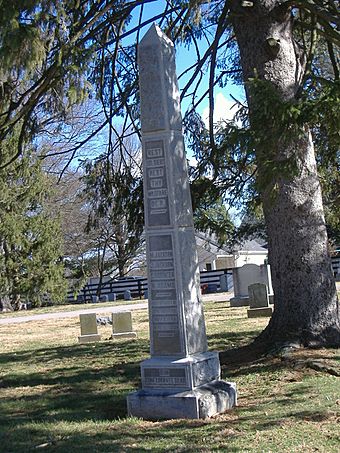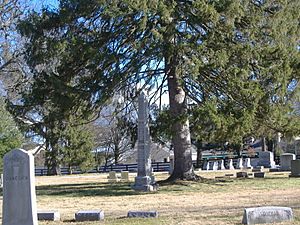Martyrs Monument in Midway facts for kids
Quick facts for kids |
|
|
Martyrs Monument in Midway
|
|
 |
|
| Lua error in Module:Location_map at line 420: attempt to index field 'wikibase' (a nil value). | |
| Location | Midway, Kentucky |
|---|---|
| Built | 1890 |
| MPS | Civil War Monuments of Kentucky MPS |
| NRHP reference No. | 97000663 |
| Added to NRHP | July 17, 1997 |
The Martyrs Monument in Midway is a special memorial. It stands in the Midway City Cemetery, near Midway, Kentucky. This monument was added to the National Register of Historic Places on July 17, 1997. This list includes important historical places across the United States. The monument is part of a larger group called the Civil War Monuments of Kentucky Multiple Property Submission.
The monument honors four Confederate prisoners. They were killed during the American Civil War. This happened because of a strict rule from a Union general named Stephen G. Burbridge.
Contents
The Martyrs Monument: A Special Memorial
The Martyrs Monument is a tall stone structure. It was built to remember a sad event from the Civil War. It reminds people of the difficult times and tough decisions made during that period.
What Happened at Midway?
The four Confederate prisoners were executed on November 5, 1864. This took place northeast of Midway. The exact spot where it happened is not known today.
The Story of Order No. 59
General Stephen G. Burbridge was a Union leader in Kentucky. He issued a rule called Order No. 59. This rule stated that if an unarmed Union citizen was killed, four Confederate prisoners would be chosen and publicly shot. This was meant as a punishment or warning. The executions near Midway happened because of actions by a person known as Sue Mundy. Sue Mundy was a former soldier under John Hunt Morgan. This person led raids against Union forces in Kentucky during the later years of the war.
Who Were the Martyrs?
The four Confederate prisoners honored by the monument were:
- M. Jackson
- J. Jackson
- C. Rissinger
- N. Adams
These individuals became known as "martyrs" because they were killed under the terms of Order No. 59.
From Battlefield to Final Resting Place
After they were executed, the four prisoners were first buried in shallow graves. Later, their bodies were moved to a Presbyterian cemetery. Finally, in 1890, they were moved to their current location. This is when the Martyrs Monument was officially dedicated. The monument stands as a lasting memorial to their story.


